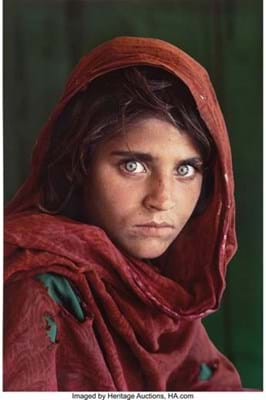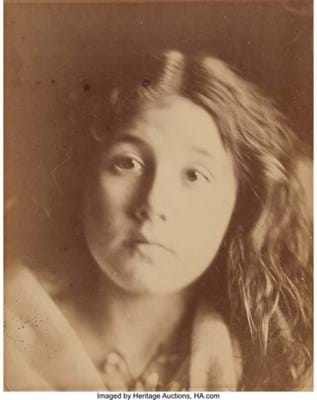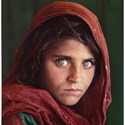Among the 430 lots coming up at Dallas auction house Heritage on October 12 are striking images by a modern master, Steve McCurry, and one of the early pioneers, Julia Margaret Cameron, that both display optical impact.
McCurry’s Afghan Girl, 1984 (estimate: $30,000-50,000) captured the attention of readers worldwide when it appeared on the cover of National Geographic magazine in June 1985. The portrait captured Sharbat Gula when she was a 12-year-old Afghan girl in a refugee camp in Pakistan, her sea green eyes showing simultaneous curiosity and uncertainty – she never had been photographed before – about the camera pointed in her direction.
“This is the most recognised photograph in the history of National Geographic – I have heard it called ‘the First World’s Third World Mona Lisa’,” said Heritage Auctions’ photographs director Nigel Russell. The 3ft 1in x 2ft 1in (94 x 64cm) ‘oversized dye destruction print’ is signed in ink lower margin recto by the photographer.
It is one of eight McCurry photographs in the auction. McCurry (b.1950) is an American photographer, freelancer and photojournalist. For more information on exhibitions featuring his work, see https://stevemccurry.com/exhibitions
Portrait pioneer
Meanwhile, Julia Margaret Cameron’s (1815-79) image of Kate Keown, 1866, is estimated by Heritage at $5000-7000. The albumen print, 14 x 11in (35.5 x 28cm), signed and inscribed in ink lower margin recto, was sold at Sotheby’s in May 2003, to a private collector.
She is described by the V&A as "one of the most important and innovative photographers of the 19th century". She had close links to the South Kensington Museum (now the V&A) throughout her career – her first museum exhibition in 1865 was held here and was home to her portrait studio in 1868. Today, the V&A collection includes over 250 of Cameron's photographs, and letters from Cameron to Sir Henry Cole, the museum's founding director.
Cameron’s photographic career stated relatively late in life – her first camera was a present from one of her six children – but she became well known particularly for images of eminent Victorians such as Thomas Carlyle, author Charles Dickens, inventor John Herschel and poet Alfred Lord Tennyson.
The Museum of Modern Art says that Cameron, a “well-read, educated woman”, often pressed her subjects into posing for “pastoral, allegorical, historical, literary, and biblical scenes, such as in Madonna with Children (1864). In this photograph, she transforms Mary Kellaway, a local dressmaker, and Elizabeth and Percy Keown, children of a gunner in the Royal Army, into figures in an enduring art historical scene”.
Kate Keown was one of Percy’s three children. He was stationed on the Isle of Wight where Cameron lived.
An albumen print of Kate Keown [No. 5 Of Series of Twelve Lifesized Heads], [1866], sold for a premium-inclusive £36,250 at Bonhams in London in June 2016.
Cameron’s work is popular with collectors, her profile boosted even further by a major exhibition, Victorian Giants: The Birth of Art Photography, held at the National Portrait Gallery earlier this year. It was the first to examine the relationship between four ground-breaking Victorian artists: Lewis Carroll (1832-98), Lady Clementina Hawarden (1822-65) and Oscar Rejlander (1813-75).









